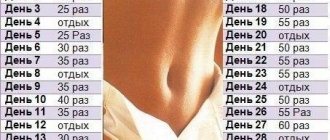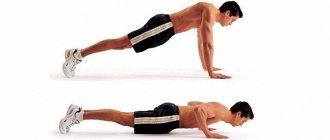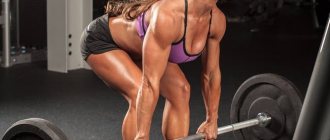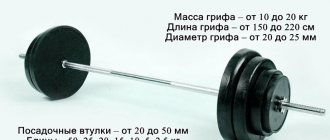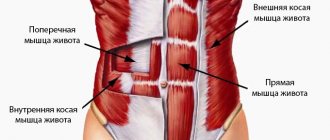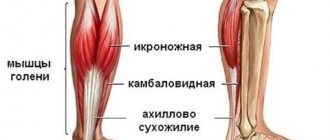Just because you can't see your back doesn't mean it isn't important to your health. You should give it the same attention in training as all other muscle groups - quadriceps, shoulders and abdominal muscles.
The back is not visible, so people rarely think about it. Unfortunately, this is the situation for many women who forget to train the muscles in the back of their torso. Too often we skip the necessary exercises for the back muscles, doing only those that load the visible areas of our body. You should stop doing this! Strong latissimus muscles, trapezius and others, are necessary for a healthy body and beautiful posture.
The back works in almost every movement we perform every day, so it is important to pump it up - to make this work easier.
In addition to the strength and functionality that a girl receives from training, a strengthened and muscular back and pumped-up shoulders allow a girl to visually make her waist much thinner. You'll also no longer have to worry about your bra constantly eating into your back fat, and you'll look great in clothes that don't cover your back. Isn't all this enough to get you started on your workout right away?
We will focus on the major muscle groups. The three most basic are the latissimus, trapezius and lower, which straightens the spine. Also, doing these basic exercises will strengthen many other back muscles, especially those that extend and rotate the shoulder joint.
The function of the lats is to rotate the shoulder inward and extend the arm. The lower back muscles are used to tilt the body from side to side or arch backward. Trapezoidal ones are used to lift the shoulder blades and rotate them upward.
In this article, we'll look at ways to tailor your workout to your body and its characteristics and ultimately develop strength, size and symmetry in your posterior muscles.
Developing your own training program
A good back routine should include at least three compound rowing exercises that target the upper and middle back muscles and 1-2 isolation exercises for the lower back.
Your choice and sequence of exercises should be varied from one workout to the next, or at least every 2-3 weeks, to ensure that you optimally engage all the back muscles during training.
Sets and reps
In general, many people get the most benefit from 10-15 repetitions and 2-3 sets of one exercise. This value will vary slightly as your training, physical strength and goals are taken into account. Women who just need to maintain their existing figure should perform 2-3 sets of 12-15 repetitions.
Those for whom it is important to gain muscle mass should perform 3-4 sets of 8-12 repetitions. To gain physical strength and pump up, you should perform 3-4 sets of 6-10 repetitions.
You can use all three of these tactics in your program for variety. For example, if you need both strength and volume, you can combine the two tactics, alternating between sets of 8-12 reps and 6-10 reps.
Other muscles that are trained along with the back
The rear deltoids and stabilizing muscles are usually trained along with the back because they are involved to some degree in many exercises. In addition, it is advisable to add exercises to the training program that exclusively strain the teres major and minor muscles, as well as the trapezius.
Although all three of the above muscles are involved in many back exercises, if you want to develop them more, you can add specific movements that target them.
You can also combine pumping your biceps with training your back. It is useful to combine both deadlift exercises for an effective workout to reduce your time spent in the gym.
Frequency, duration and intensity
One of the best styles of fitness plans divides workouts into exercises for individual muscle groups. Each muscle group is given its own day or combined with 1-2 other muscle groups. This allows you to completely treat an individual muscle to stimulate its growth. If your back is one of your weak points, you will benefit from prioritizing it by doing exercises that target it twice a week. We will talk about prioritization further.
Your workouts should not last more than an hour a day. This time is enough for the trained muscle to become completely tired. If the class lasts more than an hour, then you need to stop chatting in the gym - you came to work out, not to talk.
The intensity of the exercises has already been discussed above, where shoulder muscles were also discussed. It all depends on what you can do yourself. Do you have enough willpower? Can you force your muscles to do something you don't want to? When you're at the end of a workout and ask yourself, "Should I stop here or do one more rep?" how do you answer that question?
Instead of asking such questions, why don't you simply tell yourself to squeeze everything possible out of this weakening body? Don't say you'll do one more, two more, or four more. Push until you are completely weak, as if your life depended on these repetitions.
Why is this so? Because you are only held back by the boundaries with which you limit yourself. If you firmly decided to stop at 40 kg when performing a bench press, how do you know that you cannot lift 50?
The intensity depends entirely on willpower. Instead of being happy that you completed the workout, you should ask yourself what would happen if you added two more weights to the barbell. You can say that you don't know anything until you try!
How to build a back-supported microcycle
I would like to note that the options proposed below and any splits are, in principle, aimed at more or less experienced people with at least six months to a year of training experience, good muscle tone and established exercise technique. Until then, full-body workouts will work great for you, and they will be much more effective for basic muscle development.
It’s most convenient to do a four-day split in the following format (I personally worked in approximately this mode for four months at the end of last year):
- Monday - pectorals + trapezius + deltoids (one basic type of dumbbell press, one for the rear deltoid to finish it off after the deadlifts).
- Tuesday - legs (plus any lagging groups as desired, for example - neck).
- Wednesday - rest.
- Thursday – back (forming exercises) + deltoids (emphasis on the middle delta, for example, rowing a barbell to the chin + swinging dumbbells to the sides).
- Friday - arms (2-3 exercises for triceps, 1-2 for biceps, since he did a good job on deadlifts on Thursday).
- Saturday is rest.
- Sunday is rest.
To study Salt in the back
You’re too lazy to go to the gym four times a week or you just don’t have enough strength, then here’s a three-day split:
- Monday - pectorals (two exercises, for example, bench press and dips or dumbbell press on an inclined bench at 30°) + trapezius + deltoids (two basic exercises, for example, military press and barbell row to the chin).
- Tuesday is rest.
- Wednesday - legs (3-4 exercises) + triceps (2 exercises, for example, close-grip press and French or cable extension).
- Thursday - rest.
- Friday - back (forming exercises) + deltoids (one exercise on the back bunch) + biceps (a couple of basic exercises like PSB and lifting dumbbells while sitting on an inclined bench).
- Saturday is rest.
- Sunday is rest.
Working towards specific goals
Safely adding mass
Regardless of the purpose of your training, be it for competition or just for health, a wide and strong back is a sign that you are doing your training correctly. Core exercises such as deadlifts are the best for adding size and strength to your back muscles. But add high-intensity rowing exercises into the mix, and you're sure to develop a back that deserves an award.
Traditional deadlifts are a must for a good back. The row directly targets the spinal extensors, but the glutes, quads, and calves are also involved. Stabilizers also work - trapezoidal, bladed and diamond-shaped. You'll be hard-pressed to find an exercise that hits more muscles than the deadlift! By performing it with heavy weights and at high intensity, you build strength and size that cannot be achieved in other ways.
To perform deadlifts safely and correctly, you need to perform the first few reps without any weights at all.
Make sure you have excellent technique before adding weight to the barbell. Add weight slowly. It is recommended to perform the entire first set without weight. To begin the exercise, squat down and grab the barbell with the grip you prefer.
Contract your shoulder, back, and core muscles, then, in one powerful motion, extend your hips and knees upward. About halfway up or when your knees are three-quarters extended, straighten your hips fully and return your shoulders to a standing position. Return to the starting position and repeat.
You should remember that deadlifts can be a dangerous exercise if not performed correctly.
It is important to warm up your body at the beginning of your workout by doing moderate-intensity cardio. It is recommended to purchase special gloves that will prevent the barbell from slipping out of your hands. You can also wear a belt to prevent injury to your lower back.
Other good ways to gain mass are to train at full intensity and use as heavy weights as possible. The last 2-3 repetitions should be performed with force, that is, you cannot perform another repetition without losing form. Perform four sets of 6-10 reps to focus on gaining muscle mass. You can also prioritize body parts, which will be discussed later in the article.
Workout at home
Training at home is quite easy if you have 2-3 simple things: a barbell, 2-3 sets of dumbbells and a pull-up bar. Even with the first two rounds you can build up your back. You can deadlift and perform rows with either dumbbells or a barbell. Dumbbells can be used for a variety of exercises such as one-arm rows, delt rows and pullovers.
To perform barbell exercises at home, you need to be creative. Find something you can attach to the notch on the bar where the weight plates fit. These will be the handles. It is better to use a very short expander for this.
This will allow you to keep your hands straight while you perform this exercise. You can also use a rope or towel, but these options put more stress on the hand, so refrain from using too much weight.
Variety of exercises
There is no problem with lack of exercise. There are literally dozens of varieties and variations of the pull alone. There are also modified pull-ups and rows. The main thing is to always change your schedule to stimulate your muscles differently for new growth.
Symmetry
Back development is very important for those who are going to competitions, but it is also important for all other people interested in their figure. A strong back shows off your strength and makes your waist look narrower in comparison.
When judging a figure in a competition, they usually look for a wide, symmetrical and defined back. Your back should be wider just below the shoulders and should taper towards your lower back and waist. Well-developed deltoids are equally important, as they tie the entire look created by training.
To balance the appearance of your back, you need to know which areas (top, middle or bottom) are less developed. When you have discovered this, you need to improve your training a little so that the less developed area gets more attention.
If your weakness is in the upper back, perform the exercises with a wide grip. Pull-ups, various rows - we do everything with a wide grip.
To avoid cutting back on your movements, don't use too heavy a weight. Good exercises for developing the middle part of the back include rows with dumbbells, either with both hands at once or one at a time, and rows of the lower block on the machine.
To focus on your lower back, you should be doing mostly deadlifts, hyperextensions, and reverse extensions.
Isolation exercises
It is almost impossible to isolate the spinal muscles. Many beginners perform all the back exercises almost without noticing that they are straining. Until you become an experienced powerlifter, you will not get a quality brain-muscle connection. However, the back muscles can be developed without isolation.
How will you know that you are not isolating the muscles. Firstly, you will not notice a burning sensation or fatigue in your back - most often only your arms will burn. And secondly, you won’t even enjoy the workout.
Isolating a muscle means learning to contract and relax it separately.
Prioritization
If your back is one of your weak muscle groups, then you need to prioritize it. The best way to do this is to deadlift! And this is not a joke or an exaggeration. It's already difficult for women to gain muscle mass, which is why you need to do heavy exercises, of which the deadlift is the best. Since it takes 7 to 14 days to rest after an intense deadlift program, you should vary your workout each week.
Another reason to vary the program is to stimulate the muscles with different numbers of repetitions, different intensities and assortments of exercises in order to maximize the strength of the back in the minimum amount of time.
In addition, on other days you can perform different analogues of the row, again stimulating the back from a different angle.
You're giving serious weight!
It bears repeating again - as a woman you need heavy exercise! There is no why or why! If you are serious about achieving your goal, you need to fearlessly add pounds to your barbell until you reach your goal.
Don't be afraid of weight. It can seem very intimidating to walk up to a barbell that has 60kg of weight hanging on it. Picking it up seems even scarier. But this shouldn't worry you. Attack her with all your intensity!
You need to mentally overcome all obstacles in your path by willpower - the number of repetitions, the burning sensation in your muscles, and the desire of your body to stop. You need to already see in your mind how you made your way past all these obstacles and reached your goal. Think how nice it will be to win! And the next time you will approach this bar without a single doubt, since you have already shown it who is boss.
Example of a 2-week back training program
This workout will add width, definition and strength to your back muscles. The first week will focus on the deadlift, and the second week will build on it, stimulating the entire back at the same time at maximum intensity. If you have an area of weakness, you can replace several of the exercises in week two with ones that target the area that you have underdeveloped.
If you want to train your back and biceps at the same time, simply replace the lat pull-down with four sets of barbell curls for biceps, performing the following number of reps in this sequence: 12, 10, 6, 6, 4.
Week 1
Warm up with 5-10 minutes of moderate cardio and stretching.
| Deadlift – 5 sets, 15, 10, 8, 6, 4 reps | |
| Pulldowns - 4 sets, 12, 10, 8, 6 reps | |
| Wide grip lat pull-down - 3 sets, 12, 10, 8 reps |
Week 2
Warm up with 5-10 minutes of moderate cardio and stretching.
| Dumbbell rows 5 sets, 15, 12, 10, 8, 6 reps | |
| Pull-ups 3 sets, 12, 10, 8 reps | |
| T-bar row 2 sets, 10 reps | |
| Hyperextension 2 sets 10, 8 reps |
If you want to train your back and biceps together, simply perform a hyperextension immediately after your pull-ups and replace the T-bar row with four sets of ez-bar biceps curls. Perform 12, 10, 8, 6 repetitions. After this, add another arm raise exercise at any time for the same number of repetitions. It is also useful to do arm raises with dumbbells.
Deadlift
Deadlift is one of the basic exercises aimed at working the spinal muscle tissue. This complex loads many joints and additionally pumps all major muscle groups.
- To perform the exercise, you need to stand in front of the barbell in the “shoulder-width toes” position (you can also choose a pose with a narrower leg position). After taking the starting position, you need to bend over and grab the barbell with your hands, while your hands should have exactly the same width as the distance between your shoulders.
- When the upward movement begins, the weight is lifted due to the work of the muscle tissues of the legs, the back remains motionless. In the second phase of the exercise, the back muscles come into play, and it is at their expense that it is necessary to push the barbell to the groin.
- After the projectile is in the lumbar region, it is necessary to lower the barbell to the floor along exactly the same trajectory along which the lift was performed.
Effective back training program for girls
Here is another proven and effective program. She has already helped many girls tighten their back muscles and gain a beautiful figure. We hope it will help you too:
| Wide grip lat pulldown 4 sets of 12-15 reps | |
| Bent-over dumbbell rows 4 sets of 12-15 reps | |
| Bent-over barbell rows 4 sets of 12-15 reps | |
| Lower block rows 4 sets of 12-15 reps | |
| Reverse grip lat pulldown 4 sets of 12-15 reps | |
| Pull-ups 4 sets of 12-15 reps |
Important: Your workout should be modified occasionally to avoid plateaus. So, some weeks we do 5 sets of 10 or 12 reps, and some weeks we do different exercises. Although it is nice to have a set program, it is still better to change it so that it does not get boring.
A set of exercises for the back and shoulders for women
This upper body exercise program will help women build strong shoulder and back muscles. Only dumbbells required.
Description of the training:
- The goal is to gain muscle mass;
- Type of training – for one muscle group;
- Difficulty level – for beginners;
- Duration of the program – 6 weeks;
- Days per week – 2;
- Training time – 45-60 minutes;
- The necessary equipment is only dumbbells and your own body weight;
- The training is designed for women.
Program description
Often, women have a disproportionate body with more developed leg muscles, this is because they do not take care of the upper body.
Researchers have found that a shocking number of women have very little upper body development. And this is typical for absolutely all women, regardless of age.
For many girls, it’s difficult to do even one push-up or pull-up!
However, they would benefit greatly from developing these muscles because they are needed in many daily situations: women sometimes have to carry heavy things, lift children and perform many other tasks.
If you have a strong upper body, you will not only look better, but most importantly, you will be able to meet the needs of your family and work.
If you work out at a gym, you won't have any problems - they usually offer a variety of weights. If you work out at home, you can buy larger dumbbells as you progress.
Workout program for women
| Dumbbell press 3 sets of 12 reps | |
| Vertical row 3 sets of 12 reps | |
| Bent-over dumbbell rows 3 sets of 12 reps | |
| Dumbbell flyes 3 sets of 6-10 reps | |
| Push-ups 3 sets to failure | |
| Pull-ups 3 sets to failure |
Training Tips
- Bench press Start by holding the dumbbells at shoulder level and lift them overhead. Slowly and in a controlled manner return to the starting position. If three sets were easy to complete, try using heavier dumbbells.
- Vertical traction. Start by lowering your arms down, holding the dumbbells in front of your hips. Raise the dumbbells to your chin, bending your elbows.
- Bent-over dumbbell rows. Bend slightly at the waist, keeping your back straight. Make sure it doesn't get rounded. Allow your arms to hang calmly on either side of your body. Slowly bend your elbows and lift them, do not spread your elbows, keep them close to your body, move your shoulder blades towards each other. Lower your arms in a controlled manner to the starting position.
- Raises with dumbbells. Start by keeping your arms down. Slowly raise your arms until they reach shoulder level. After this, slowly lower them to the starting position.
- Push ups. If you can do them, do 3 sets. If you can't do even one, start with the knee push-up position. You can also try this approach: lie on the floor, then get on all fours and, controlling the technique, lower yourself to the floor.
- Pull-ups. Pull-ups are an essential exercise for a beautiful back and strong shoulders. If you find it difficult to do one pull-up, you can try jumping pull-ups - jump up to the bar, then slowly lower yourself down. You can also attach a long rubber belt to the bar to help you do pull-ups.
If you don't have either of these options, you can throw an expander over the door and pull it down. Take both ends of the resistance band over the door while sitting near the door. Pull the resistance band down with both hands until your arms are level with your shoulders. Slowly return to the starting position.
Don't be afraid to increase the weight as needed when you're trying to build muscle mass.
Continue working on your pull-ups and push-ups. Sometimes it takes more than a year to learn how to do them correctly, but both of these exercises are essential for the silhouette you want.
Bent-over barbell row
The following exercise is performed primarily to target the trapezius and latissimus dorsi muscles, while also working the biceps and rear deltoids.
You need to prepare for the exercise as follows: place your feet at a comfortable distance and bend your knees. You need to start lifting the barbell with a straight grip of your hands, without bending them at the knee joints. To make it easier to lift the training apparatus, you need to lean towards the bar at an angle of approximately 30 degrees. After bending forward, you need to bend forward at the lower back and bring the barbell to the level of your knees, after which, using tension in the lumbar muscle tissue, the projectile is brought to the abdominal area
When performing a lift from the knees to the abdomen, you need to pay special attention to the work of the back muscles: many beginners make the mistake of lifting the barbell with their biceps, as a result of which the beneficial effect of the action is reduced to zero. After the barbell is raised to the level of the abdomen, it is necessary to fix it at the achieved height for a few seconds, after which the projectile is returned to the floor along the same path.

